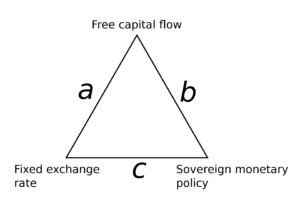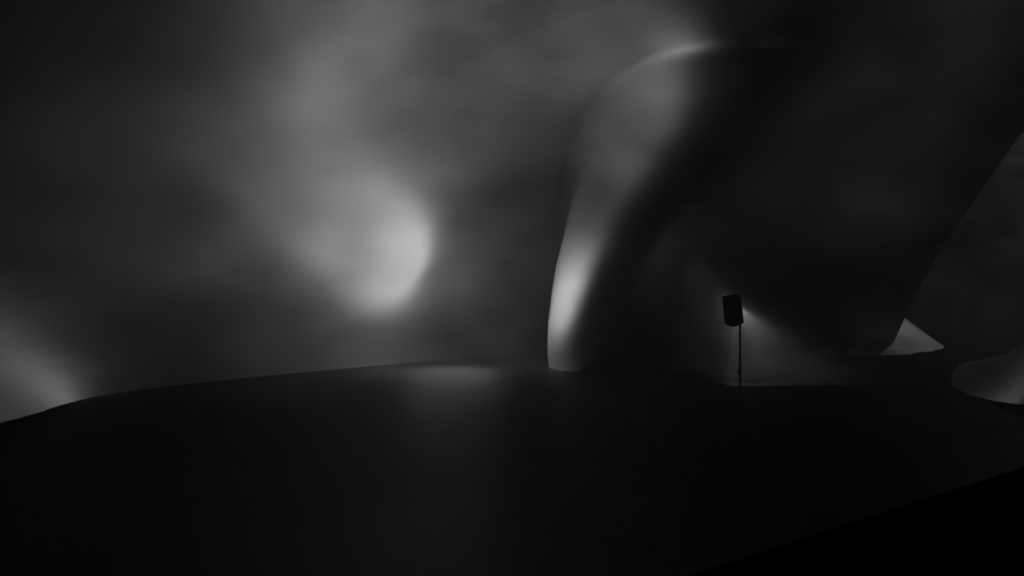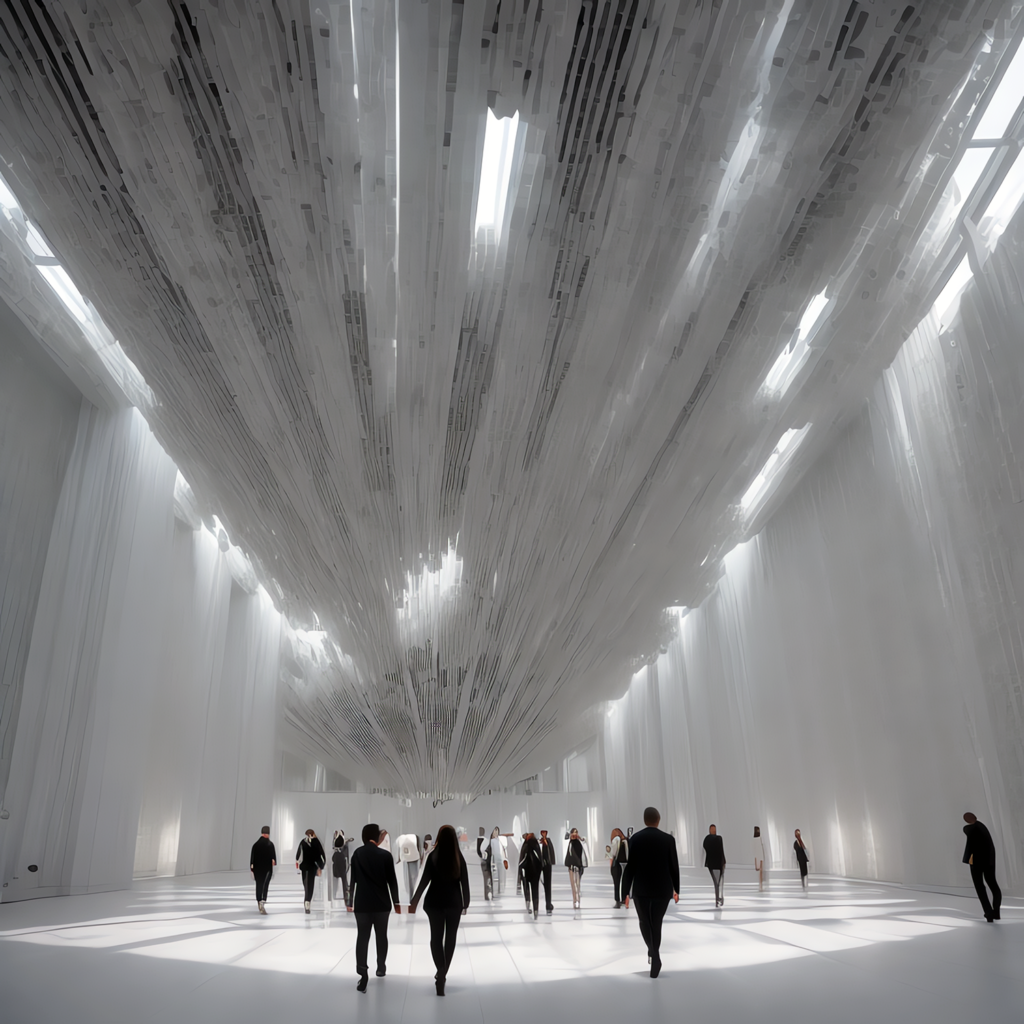 |
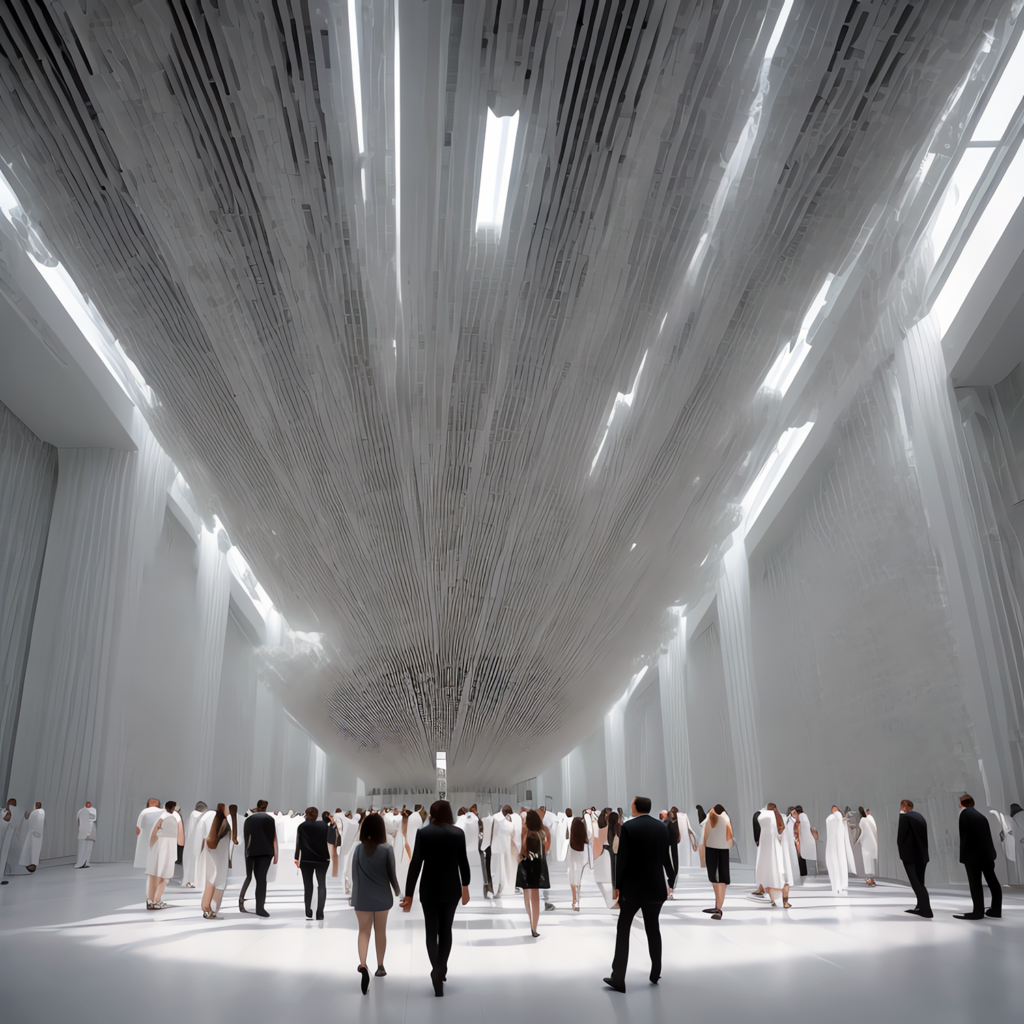
|
|---|
01_2023
+++++++++++++++++++++++++++++++++++++++++++++++++++
The Impossible Trilemma aims at “making the impossible”; materializing it by expression or fabrication. The premiere will take place at CLab, Taipei on November 10th, 2023. The setup consists of a set of speakers oriented into very precise angles and positions. The diffusion space is primary as its reflections are used as synthetic resonators. A dimmed light design with neons is also part of the piece.
The following text is then just an early and simplified presentation of the project.
The correlation between thoughts, their materialization, and perceived outcomes indefinitely interrogates me. Probably because of the relative expression difficulties I often encounter. The Impossible Trilemma thus explores several questions about the limits given by oneself, by society, and by imagination. As for the previous piece The Nudge, it is intended to remain an abstract depiction of a situation and thus leaves the listener any choice of intimate interpretation and drive. One could see that as a theatre-music manner, and style.
Playing with an impossible trilemma in a piece may seem fanciful. However, there is no necessity to use reality in a piece, the spectrum of possibilities is as wide as imagination goes. The width of possibilities obviously stretches even more when using serendipity or any other tool for discovery such as indeterminacy or algorithms. Just expressing it could nevertheless expose unattainability. Giuseppe Verdi’s La Traviata is the ideal example showing obstacles in accessing other social classes in Europe at the time of The Lady of the Camellias. Verdi’s opera comes straight from that Alexander Dumas‘s 19th-century novel.
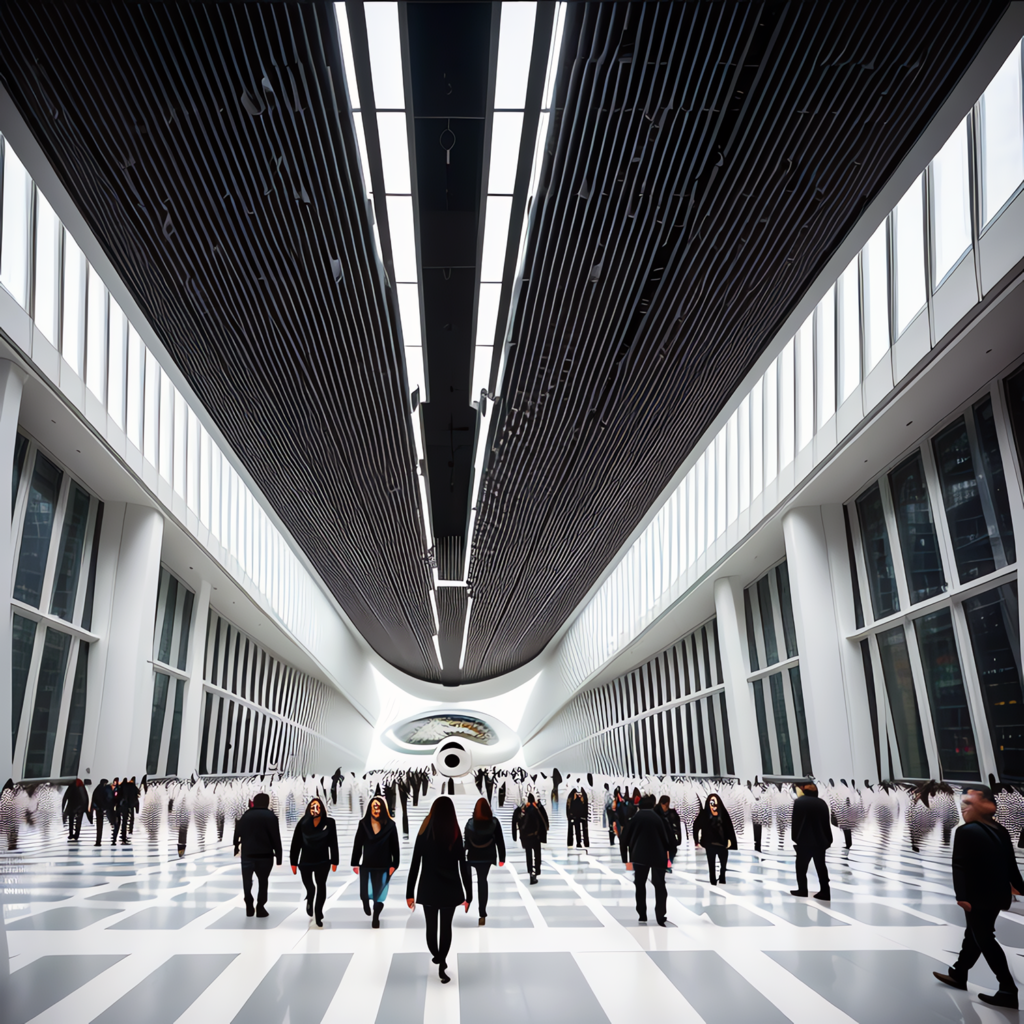 |
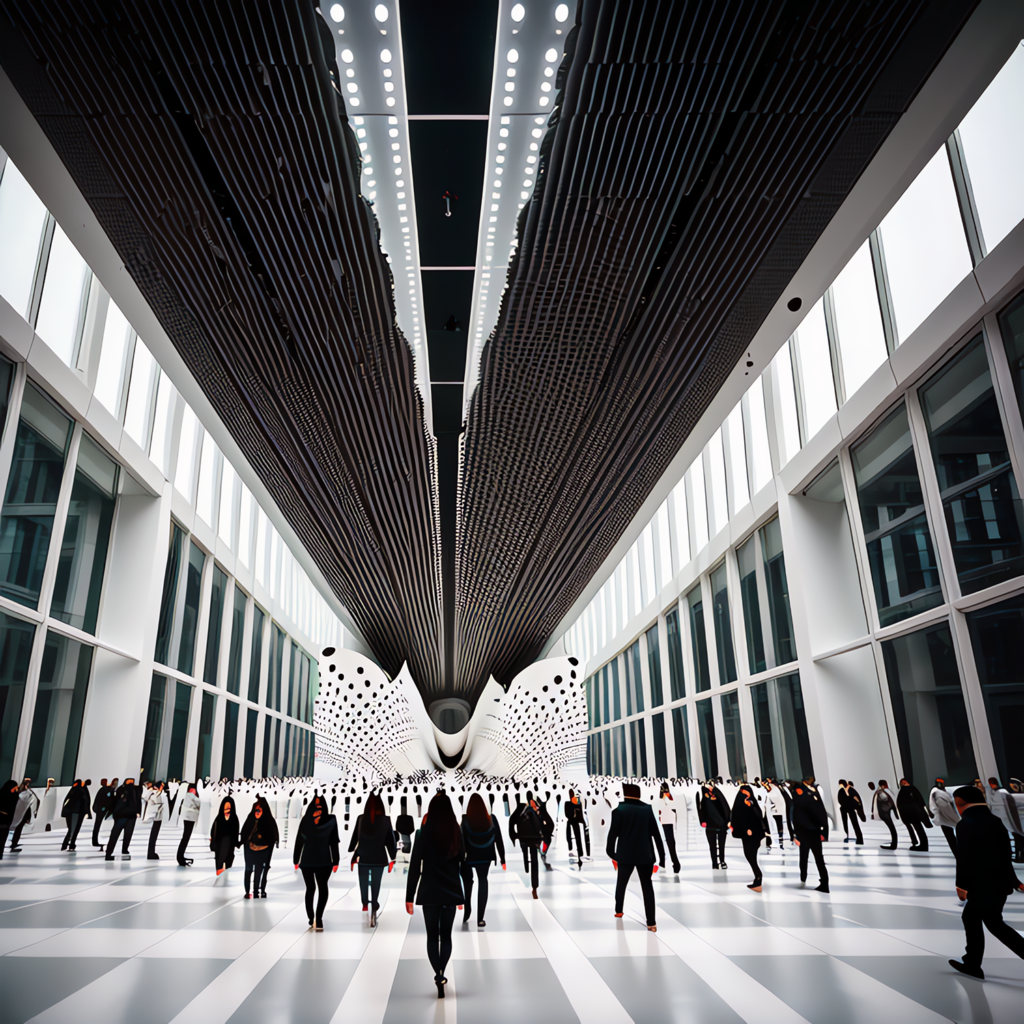 |
|---|
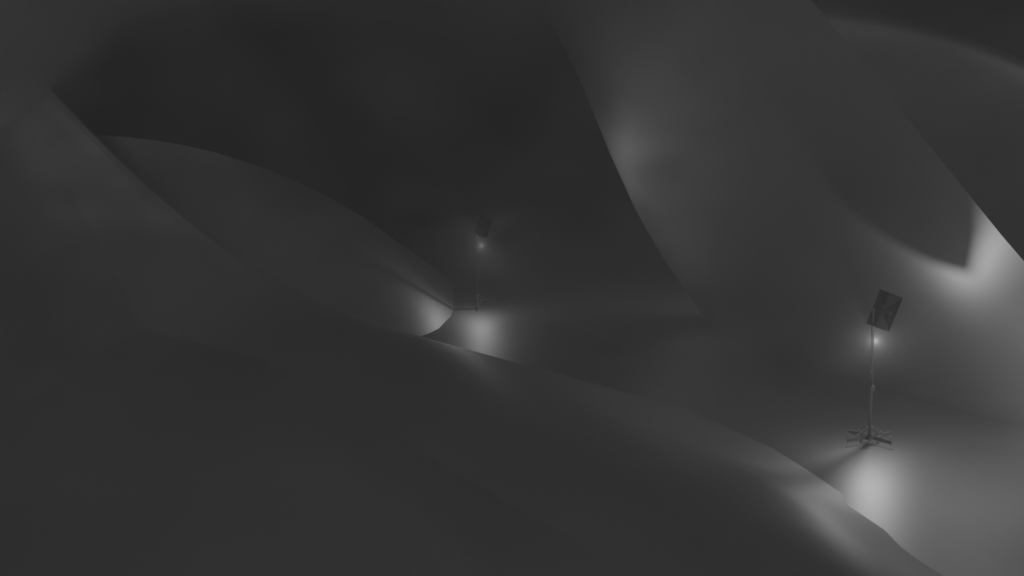
audio and visual simulation of the piece
SYNOPSIS:
Here are four relevant examples that have no link to each other. Linking them would make me an “extreme rationalist” as Albert Einstein calls them. I just want to illustrate the various implications and impossibilities they describe. At first sight, rules are just framing what is possible. More precisely each example is much more subtle than that. They show that discriminating systemic impossibilities either from Nature, from human nature, or from imagination is at first barely possible.
Early 20th-century physics:
The impossible does exist and merely contains all that is not possible.
Light speed is finite and partial differential equations reveal a cone. Any event (any point in the grey region on the left picture) in the future light cone has not received the light yet but it will eventually. As time goes by, the event is closer and closer to the center. When it reaches the center is the exact moment when the light affects and reaches it. What happens outside the grey region is a question intrinsically linked to light speed and therefore space-time topology.
This view will play an important role in the piece as we will deal and play with the limits of sound speed and the human limits of discriminating patterns in music. What is the music beyond those limits in a poetic way?
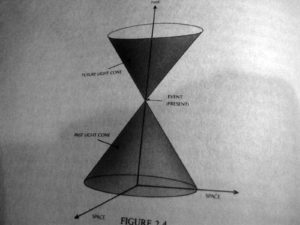
light cone in special and general relativity plays an essential role in defining causality.
the belief of how the latter works are important in music.
Late 20th-century economics:
The Impossible Trilemma in economics asserts that none of the following three things can exist simultaneously:
– a fixed foreign exchange rate
– free capital movement (absence of capital controls)
– an independent monetary policy
It is said that this limit caused the Asian financial crisis in 1997. A country can only control two sides of the triangle. This asserts that it has to choose between reducing currency volatility and running a stabilizing monetary policy. Stabilization is tightly linked to time. Fast transactions, using hyper-trading for instance, still follow the rule. Using transnational currencies, such as Facebook’s Diem or Bitcoin, does not bypass the rule either… I believe. There seems to be an unwavering boundary that goes beyond economic policies and political choices.
Universal laws in physics:
The two previous examples are factual. But the process for their discovery, or construction, is far from obvious. Observing the world does not help to deduce laws. Galileo’s law of gravity, for instance, shows it is rather the opposite; a simple thought experiment, counter-example, shows the flaw in what is seen cannot be generalized and does not work as proof. Two objects with different masses tied together will fall at the same speed… The physical laws are not deducible from the phenomena, they are hidden in these phenomena. Observation must then be reinterpreted. Alexandre Koyré describes the gamble of modern physics: we can explain the empirical reality by the impossible; using laws saying the exact opposite of what is observed.
At first, a law in physics can be seen as absurd. This sense of absurdity, or apparent nonsense, is needed for the piece. The question of a law being unperfect, invariant, or universal takes another meaning for
the impossible trilemma.
Legislation in political science:
A good political example where it is difficult to appreciate what is organizational (as “choice”) and what is structural (as “natural entropy“) is the Arrow’s Paradox which was first roughly described by Nicolas de Condorcet.
Let us suppose that each voter can only express his opinion in a qualitative manner, by indicating how he ranks the options considered in relation to each other. Between two options, the voter indicates which one he prefers or if he is indifferent between the two, but he cannot express the intensity of his preference. In this framework, there is no indisputable social choice process that allows a coherent hierarchy of preferences to be expressed for a community based on the aggregation of the individual preferences expressed by each member of this same community. For Condorcet, there is no simple system that ensures this consistency. Arrow mathematically demonstrates that there is no system that ensures coherence at all; except the one where the social choice process coincides with that of a single individual, sometimes called the dictator, independently of the rest of the population.
The difficulty and risks in such reasoning are metaphysical or moral appreciations. For instance, how much necessity, possibility, and causality are there. Again, those appreciations have no cartesian connection. For example, knowing that there is the same number of positively and negatively charged particles in atoms hardly tells us what should be made of parity in politics.
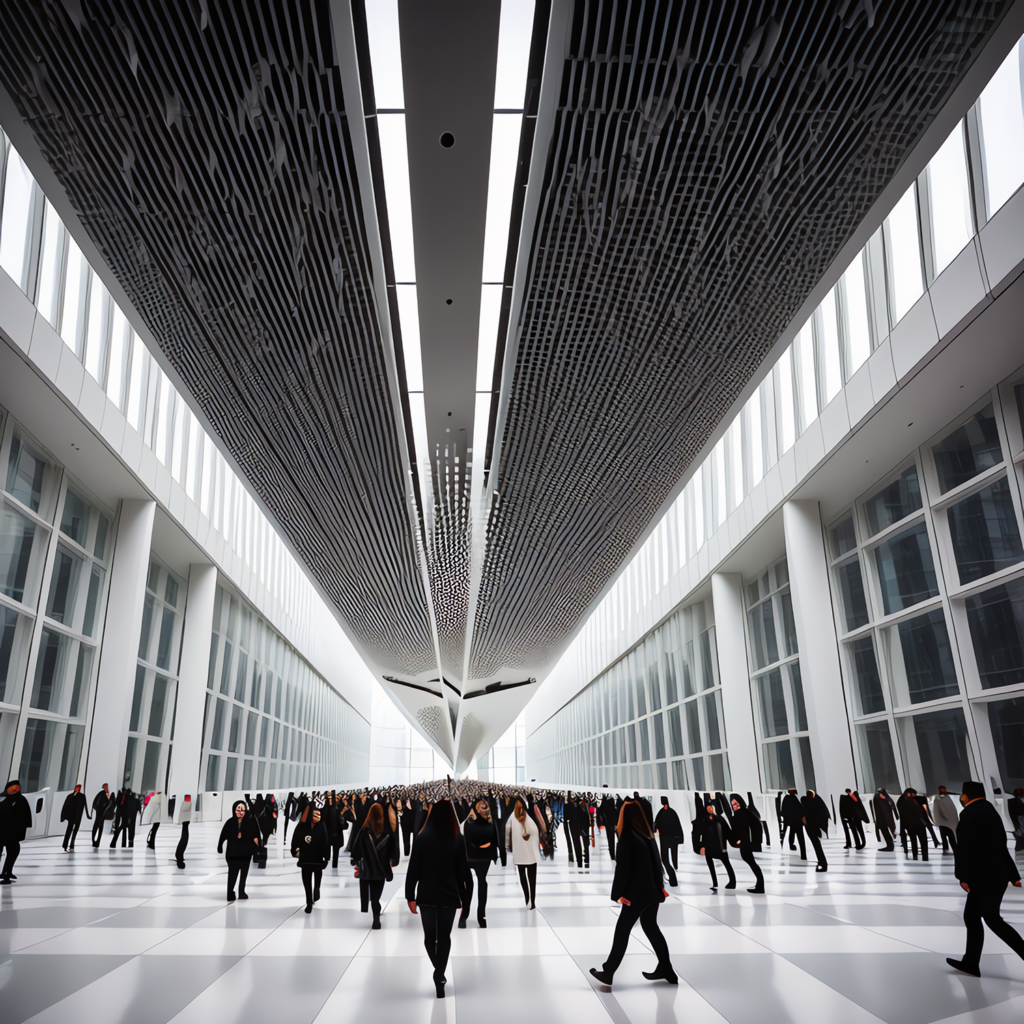 |
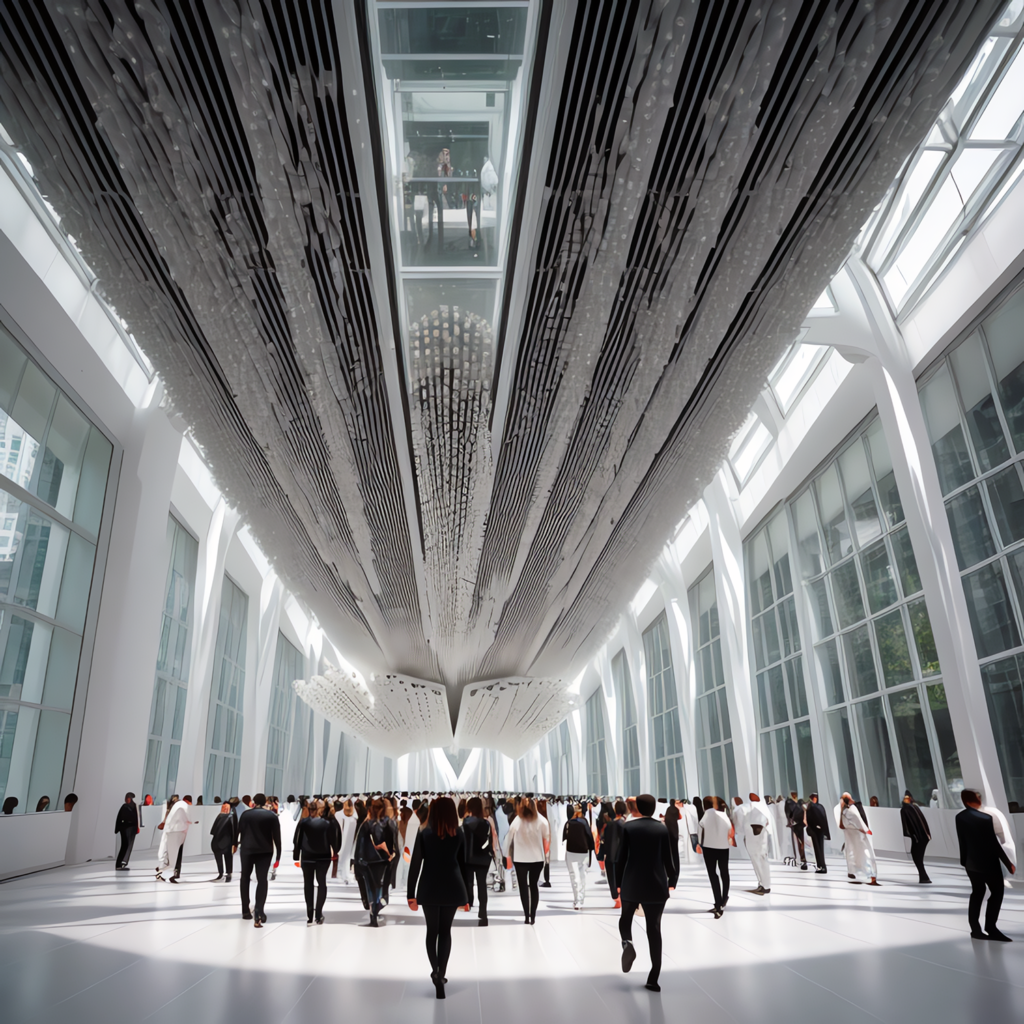 |
|---|
THE MATERIAL PIECE:
Transgressing the impossible is hence the main plot of the piece. That one is far from unique but what matters is what is done from it.
I will not describe all possibilities I imagine for breaking the impossible in the piece. Most of them will come at the time of composition. The piece deals with a trilemma so one may preferably need three main concrete elements one can later compose with.
The following ones seem pretty obvious from my past compositions.
Voice synthesis:
Abstract text, barely understandable, and synthetic voices are one possibility. That was used in previous pieces like The Nudge (2022), Principles of the Theory of Wealth (2022), or Extraordinary Voyages (2021). I myself developed a voice synthesis engine so it could become not only a means of expression but, more importantly, an instrument providing a specific aesthetic. I probably have the intention to also use it purely as a musical vocal source without so much text.
Beyond powerful lyrical capabilities, the engine alloys me to sculpt articulations that would not be possible from real voices while keeping my sharp pointillistic and rhythmic aesthetic control.
Architecture:
The Impossible Trilemma is supposed to be presented in the Tutu Galerie of the National Taichung Theater.
I find it difficult not to take the building into account probably because it is only a few years old. Its complex and the intricate interior is shaped by a continuously curved structure that has sometimes been dubbed the Sound Cave. What a perfect name for what I intend to do!
The beamless structure of curved walls, merging into floors and ceilings, creates the spaces. The architect Toyo Ito describes them as light and sound travel fluently creating a unique and extraordinary experience. Cecil Blamond, one of my heroes, was also involved in the making of this building. Structurally, it is built as a catenoid; a type of curved surface generated by rotating a catenary curve around an axis.
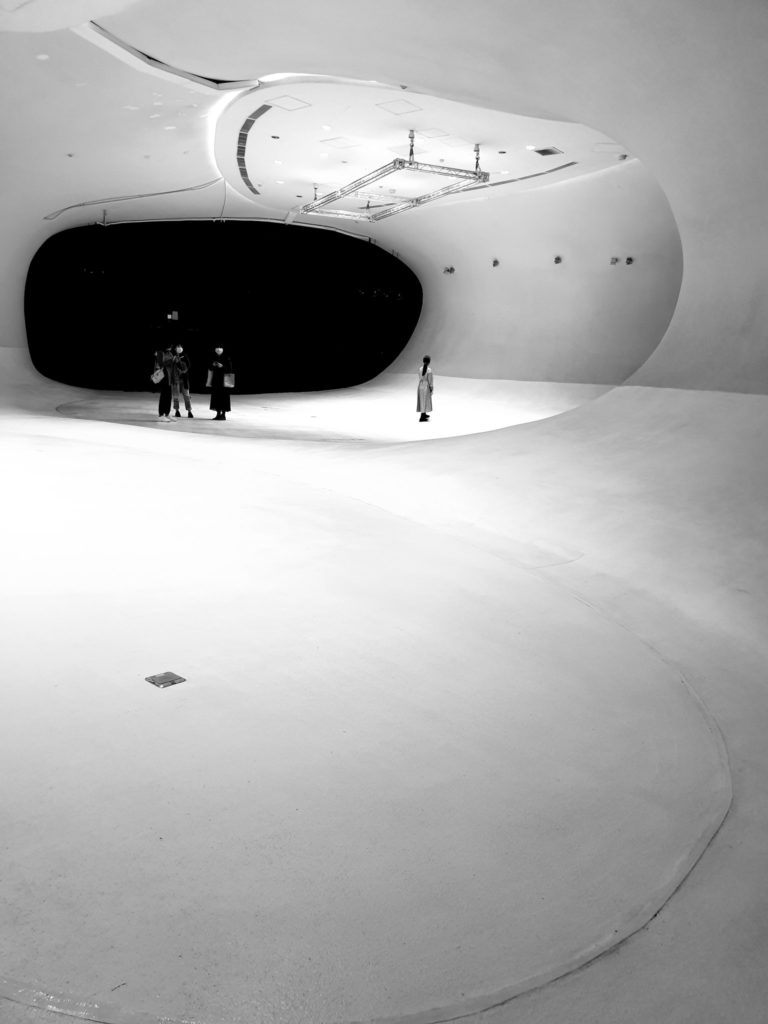
taichung national theatre tutu galerie taken by myself
For later convenience, I rather dare to see the building as a neo-futurist architecture taking morphogenesis as dynamism and plasticity. Thus, instead of using catenary curves, I am using parabolic interpolated 4d Perlin or Simplex noise to generate a structure I can later use as a resonant physical model. The used technique is rather close to what I elaborated for TOI-1842 b (2021) or Mollspeak (2021) on 3d photogrammetric museum objects.
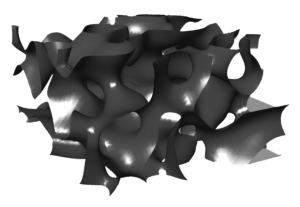
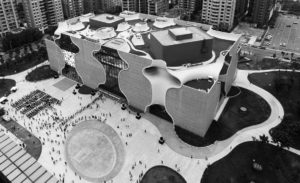
national taichung theater interpretation using 4d-noise for later virtual room acoustics.
one can see a close link with Frei Otto’s minimal surfaces thanks to the use of catenary curves.
By slicing that 4d structure, I transformed the Tutu Galerie into non-standard architecture; a model which does not have the necessity to be built in real. This is an “irresponsible” structure that can afford to be an… impossible space.
Spatial audio synthesis:
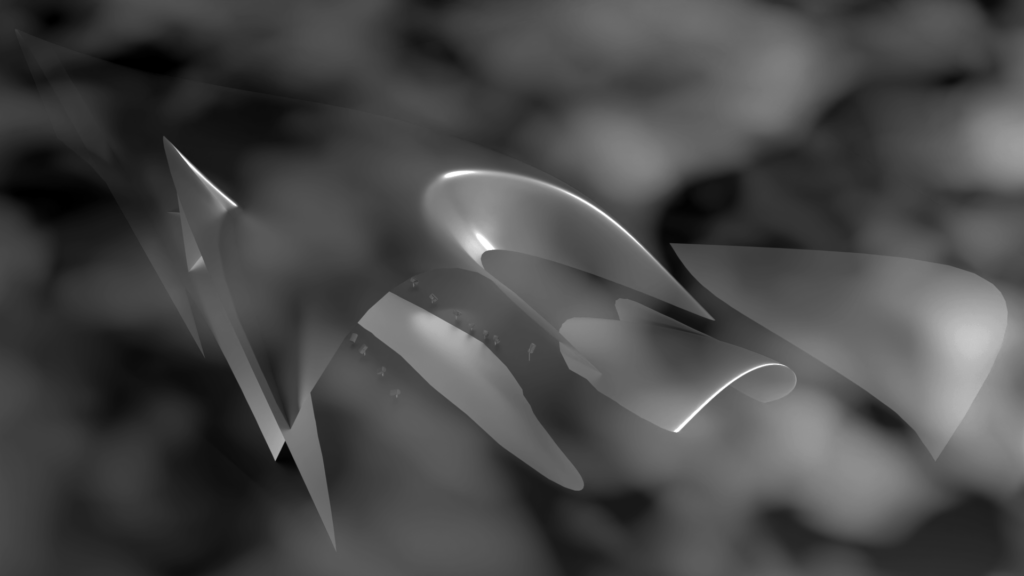
external view of the extended form of the Tutu Galerie. it differs from the actual building because we are only interested in the interior.
it nonetheless gives a good idea of how the form would spread if there were only the Tutu Galerie room.
Light: The impossible space described earlier is convenient for visual purposes. There is no intention to use any lighting in the piece. Smoke shown in the simulations is not necessary either. The Impossible Trilemma would rather be playing in the darkest possible space.
Only describing the spacial properties of the piece would not be exhaustive without displacements.
The pieces presented earlier, d [score] and TOI-1842 b, show how I artistically deal with a score for electronic music. The Impossible Trilemma is an opportunity to use the acoustics of the Tutu Galerie as a composition and not only as a resonant instrument.
Epic 201757695.02, which premiered for June in Buffalo on June 7th, 2022 makes use of Dürer, a room acoustics software in which the acoustics are totally unrealistic. Bessel functions and Finite Element Methods are being used for that. Epic 201757695.02 uses genetic algorithms to generate torus as infinite resonant loops used as complex sonic textures. Such an unrealistic space allows impossible environmental properties and transforms acoustic resonances into sound synthesis and eventually musical structures.
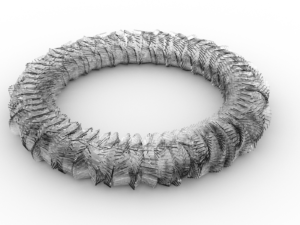
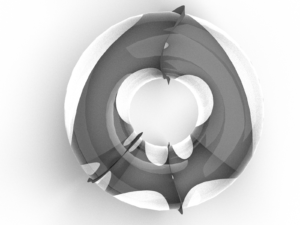
two generated donut making two specific target micro-rhythms for Epic 201757695.02.
the one on the left uses discreet scattered early reflections. the one on the right uses continuous ones using minimal surfaces.
The Tutu Galerie’s form permits doing this in a tangible way: using the richness of the space as an acoustic synthesis generator from which would emerge a musical structure composition.
Initial sounds for instance consist of continuous impulse rhythmic trains and thus keep my aesthetic signature. Because of all the angles in the space, their continuity is only heard at one specific position. A different rhythm is heard for each listener’s position. Time from the music is coming from the space itself and not the initial sounds. It is as if time was frozen and space was doing the necessary displacements to create music. I explained earlier that the light cone in special and general relativity was playing an essential role in defining causality. Space-time is also one in this piece!

acoustic modes in a rectangular room. my micro-rhythms are represented as particles in space.
only their density moves; neither their sound nor their source.
After a precise LiDAR (laser scanning), many audio IR analyses, or reconstruction of the space from blueprints, it is possible to anticipate from a model and then precisely position and rotate each speaker to get the intended rhythms. The positioning also considerably depends on the speaker’s radiation characteristics. All this can be anticipated virtually beforehand.
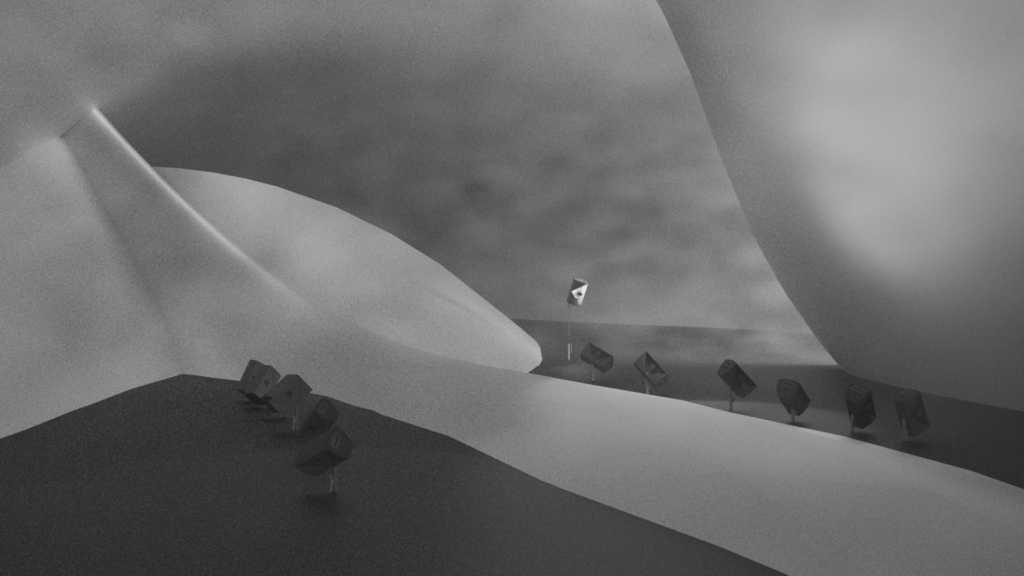
position of speakers inside the Tutu Galerie (not yet defined).
some are facing one another, others are precisely directed toward walls with millimetric precision.
Non-standard spatial synthesis:
The resulting composed architecture is made of sounds and remains intangible. The listener’s perspective of that non-standard architecture can only be heard at a specific position.
The proposition of spatial audio synthesis described earlier only works for one frequency and would still be too continuous to remain musically interesting after some time. This is especially the case with a piece of music that constantly changes at a microscopic time scale like mine.
Several interesting solutions exist from a sonic perspective. Those are just propositions at such an early stage of the project.
— Changing the sound coming from speakers. I will definitely obviously compose in a more traditional way by changing sounds and adding voices, in addition to positioning the speakers.
— Using moving sources with robots. The ICST, Zürich University has a set of robots that can extremely precisely and silently position speakers in a space. Peter Färber is taking care of that research project and would possibly become a choreographer for the piece. Nothing is sure yet here.
— Use a set of hyper-directional speakers to avoid uncontrolled running reverberances. Normal speakers can also be used. A carpet on the floor would also help a lot…
— Use speakers beams facing one another in order to generate the right interferences that the walls cannot physically achieve. The whole technical concept of the piece relies on this transgression. The piece is then a mixture of real spatial synthesis made from the walls and electronically delayed spatial synthesis using extra speakers. The technique has far common grounds with Wave Field Synthesis (WFS) but is in a way dedicated to the architecture.
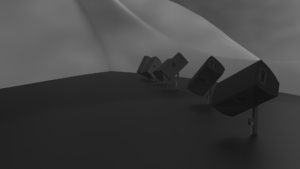
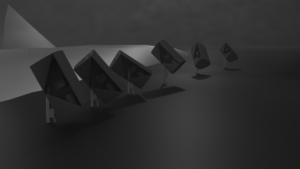
positioning of speaker beams inside the Tutu Galerie in order to get the right interferences.
Reading the space, exploring the composition:
As I sometimes do, such a generative performative installation differs every time it is played. The sound is continuous despite having a clear form; with a feeling of beginning and end. The duration for each run varies but should not be too long so visitors are offered to compare at least two performances. It is too early to say but I would guess about 20 minutes each.
As explained earlier, this piece exists through displacements of either visitors or sounds. It will therefore be necessary to decide whether the audience should remain seated or change position between performances. The concept is similar to the one in Kaspar in which readers read a linear score.
The audience could also move within the architecture either freely or by openly following enlighted marks on the floor, with seated stations. This case would be conceptually similar to the printed piece d [score] (2014), described earlier, where music is freely read.
This requires more throughs… The Impossible Trilemma is truly immersive; speakers are aurally invisible; their actual position cannot be heard. So there ultimately may not need for any audience direction. Musical solos at specific positions and times could just naturally encourage movements without the need for lights on the floor.
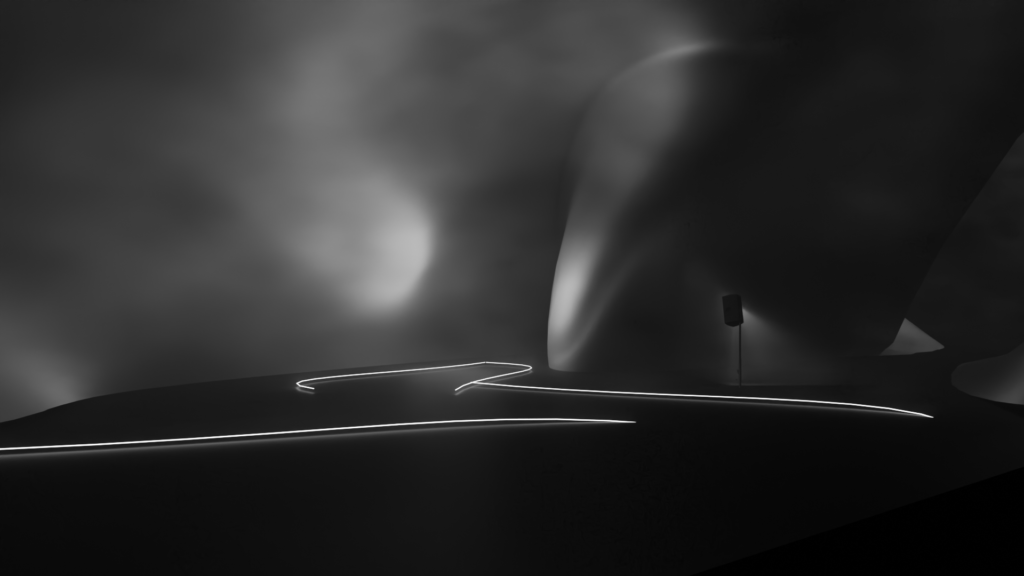
in the upper simulation, visitors are freely moving or seating in the space. Lights on the floor in the one below lead visitors to follow the evolution of the piece over the space. they can listen to time evolution when standing still and explore the spacial one when moving. same as for Kaspar
